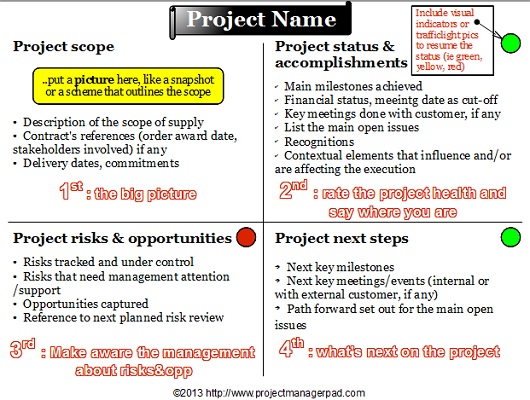Here we are! The time for the sponsor meeting comes and you have to summarize all the hard work done in the last long weeks in no more than one chart.
The management does not have hours to devote to endless presentations while you would probably spend the whole day to elaborate why this or that action is mandatory to avoid a disaster.
Nope, the stark reality is that you have few minutes to deliver the right message to the right people in the right way and in the right moment to get support and have that bloody problem solved.
Easier said than done.
I will be sharing here few tips to smartly draw the attention of your audience, especially when you cannot infuse with a magic stick all your project background to people that have no clue about who you are and what's your project.
A basic approach, not intended to be exhaustive though, is to split the content of the presentation into 4 areas, which you can tailor as you prefer on condition to include:
1) a description of what's the scope of the project (WHAT)2) a list of the milestones achieved (ACHIEVEMENTS)3) a summary of the risks and the opps you have identified and you are managing with the team (SPOTLIGHT)4) an outlook on the next milestones (WHAT'S NEXT).
To be noted that the above is good to set out the status of a project. In case the presentation is about a particular issue, an RCA, or any other problem to be stated, the scheme suggested here might change significantly.
Said that, as an example of a project 4-blocker, you may consider something similar to the below picture:
- Block #1 (left hand side, on the top):
Since you are in front of people who don't have your project background, it is worth to list down few references describing the scope of supply, when the contractor awarded the contract (if we are talking about a supply to be sold to an external customer and not about an investment of your company for a new asset or a new service) and your team gets started, when the project needs to deliver as per the schedule.
Wrap up in few bullets the above and support it with a nice picture, it will be instrumental to draw the attention of the audience and present the project magnitude.
- Block #2 (right hand side, on the top):
What you have done so far. Project team achievements, financial results consolidated at the date of the review, main milestones reached... everything goes here.
That's an important section to show what you have been able accomplish so far.
- Block #3 (left hand side, on the bottom):
This section must collect all the risks captured during previous risk reviews as a mirror in miniature of the project risk register.
If you want to deliver a message to the management about something that you probably cannot push enough without top-down support, that's the section to support your requests.
- Block #4 (right hand side, on the bottom):
People are interested in the past, more into the future. Do not underestimate the content of the fourth area as it will support you when you are speaking about the future and the path forward. Carefully summarize the next steps and highlight the deadlines.
The bullets in each area indicate the minimum content to adequately highlight the status of the project, on the other hand it has to be noted that the addition of too many items may jeopardize the effectiveness of the presentation.
In essence, be concise and bring out the key points only.


